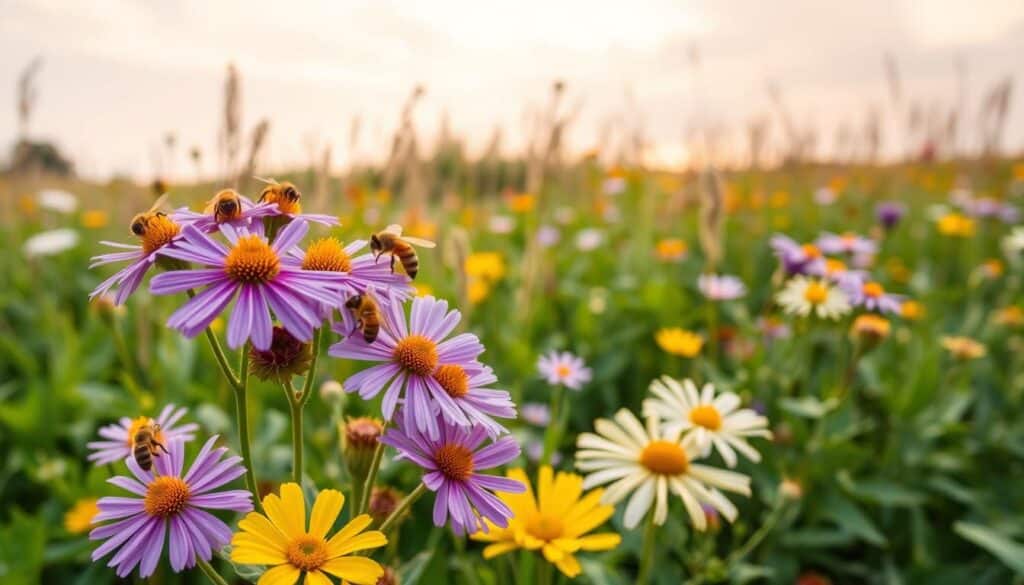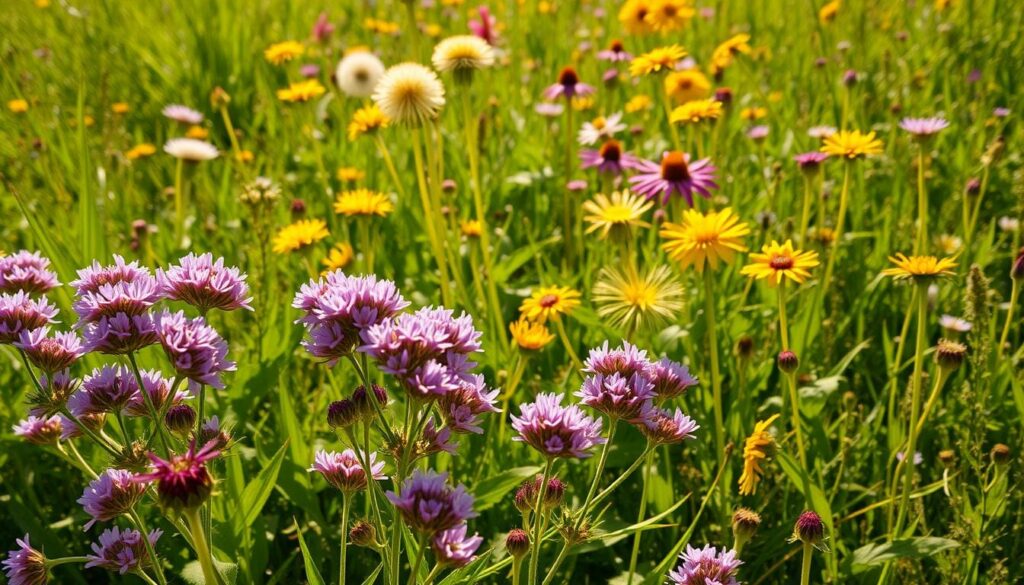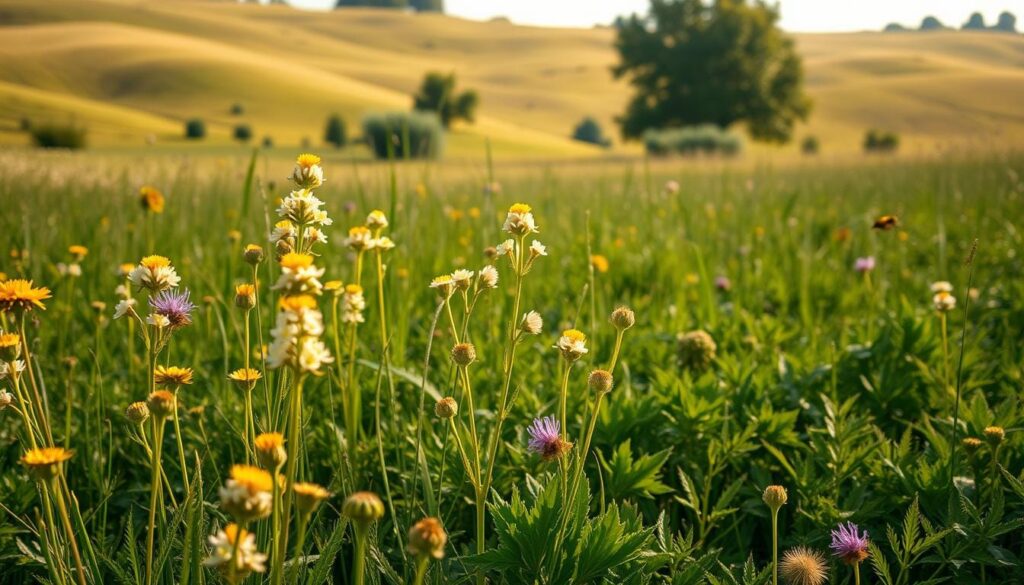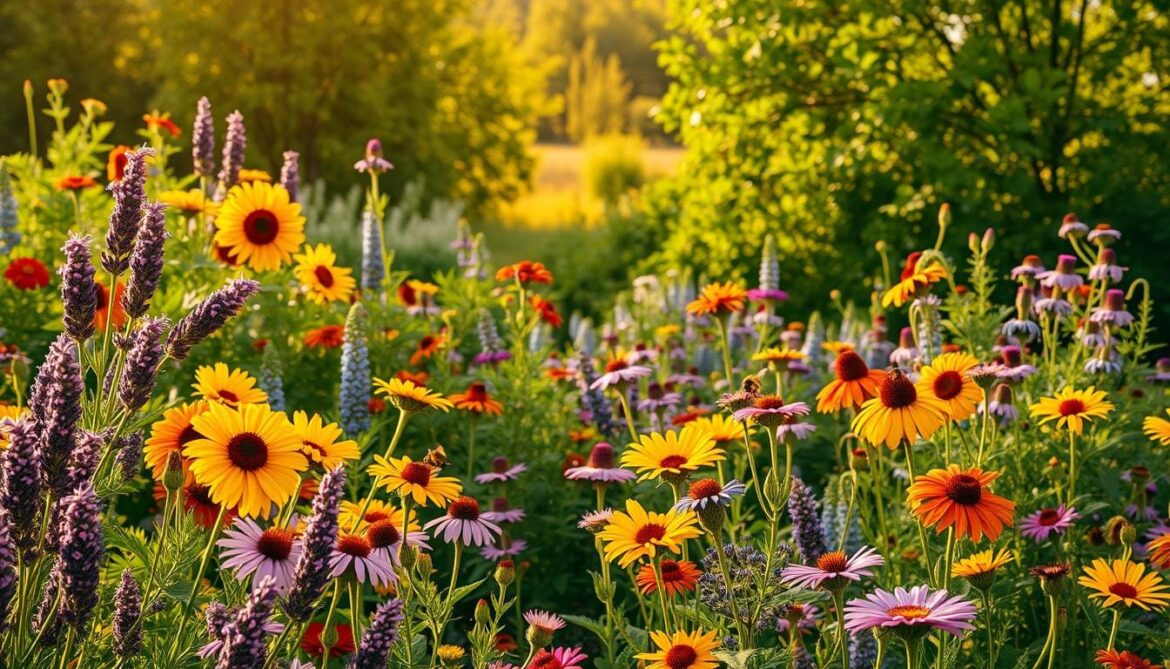Weeds are often viewed as unwanted garden intruders, competing with desired plants for resources. However, many of these so-called weeds are vital for the survival of bees and other pollinators.
flowering plants, making them crucial for biodiversity and ecosystem health. Certain weeds, rich in nectar and pollen, serve as essential food sources for these pollinators. For instance, some plants, like cannabis, may not produce nectar but do produce pollen that bees collect, especially during times of scarcity.
As we learn more about the ecological importance of these plants, our perception of weeds is changing. By understanding the role of “bee nectar weeds,” we can better support honey bees and other pollinating insects, ultimately contributing to a healthier environment.
Key Takeaways
- Certain weeds are crucial for the survival of bees and other pollinators.
- These plants provide essential nectar and pollen, supporting biodiversity.
- Understanding the ecological importance of weeds can change our perception of them.
- Bee-friendly weeds can be incorporated into environmentally-conscious gardening.
- Supporting pollinators through these plants contributes to a healthier ecosystem.
What Are Bee Nectar Weeds?

Often considered unwanted in gardens, bee nectar weeds play a crucial role in supporting local ecosystems. These plants, despite being viewed as pests by some gardeners, are actually vital for the survival and health of bees and other pollinators.
Defining Bee-Friendly Weeds
Bee-friendly weeds are plants that provide nectar and pollen, serving as a source of nutrition for bees. Examples include dandelions, clover, and goldenrod. These plants are often hardy and resilient, thriving in conditions where other plants might struggle.
The Ecological Role of “Weeds”
The ecological role of these “weeds” is multifaceted. They contribute to biodiversity by providing food and shelter for numerous insects beyond just bees. For instance, certain weeds serve as host plants for beneficial insects that control pest populations, thus supporting the balance of the ecosystem.
| Ecological Function | Description | Benefit to Bees |
|---|---|---|
| Pioneer Species | Improve soil conditions and create habitat | Provide early sources of nectar and pollen |
| Biodiversity Contributors | Offer food and shelter for various insects | Support a diverse pollinator community |
| Soil Indicators | Help diagnose soil health issues | Indirectly support bee health through healthier soils |
By understanding and embracing the role of bee nectar weeds, we can create more sustainable and supportive environments for pollinators. This not only aids in the pollination process but also contributes to the overall health of our ecosystems.
Why Bees Need These Nectar Sources

Bees rely heavily on nectar sources for their survival, and understanding why these sources are crucial is essential. Nectar and pollen from various plants are not just food sources for bees; they are vital for the pollination process that affects food production globally.
The Importance of Bees for Pollination
Bees, particularly honey bees, play a crucial role in pollination. They transfer pollen between flowers, facilitating the reproduction of many plant species. Without bees, many plants would be unable to reproduce, resulting in a significant decrease in crop yields and food diversity.
Declining Bee Populations and Food Sources
Bee populations are facing numerous challenges, including habitat loss, pesticide use, and climate change, leading to a decline in their numbers. This decline is closely linked to the availability of food sources. Bees need a diverse range of nectar and pollen sources to maintain their health and support their colonies.
How Bee Nectar Weeds Support Pollinator Health
Bee nectar weeds provide essential nutritional components that support bee health. Different weed species offer varying nutritional profiles, and together they provide a complete diet for bees. Certain weeds contain compounds that help bees fight parasites and diseases. The continuous flowering of various weed species creates a reliable food calendar for bees throughout the growing season.
- Diverse weed species provide essential nutritional components for bees.
- Different weeds offer varying nutritional profiles, ensuring a complete diet.
- Some weeds contain compounds that help bees combat parasites and diseases.
- The continuous flowering of weeds provides a steady food supply for bees.
Top Bee Nectar Weeds and Their Benefits

Certain common weeds are invaluable to bees, providing essential nectar and pollen. These plants are often overlooked but play a crucial role in supporting pollinator health.
Clover Varieties (White and Red)
Clover varieties, including white clover (Trifolium repens) and red clover (Trifolium pratense), are excellent sources of nectar for bees. These plants are rich in nectar and are commonly found in lawns and meadows. They are a valuable source of nutrition for honey bees.
Dandelions: Bee Superfood
Dandelions (Taraxacum officinale) are often considered a nuisance, but they are a rich source of nectar and pollen for bees. The bright yellow flowers are a common sight in early spring and provide a vital source of nutrition after a winter with limited forage. For more information on the benefits of dandelions for bees, visit this resource.
Goldenrod and Its Nectar-Rich Blooms
Goldenrod (Solidago spp.) is another valuable weed for bees, producing large amounts of nectar and pollen. Despite its reputation for causing allergies, goldenrod is not a primary cause of hay fever but is beneficial for bees and other insects. It’s a plant that thrives in a variety of conditions.
Milkweed: Supporting Bees and Butterflies
Milkweed (Asclepias spp.) is known for its importance to monarch butterflies, but it also provides nectar for bees. The plant’s unique flowers are a valuable resource for a variety of pollinators, supporting their health and well-being.
Other Beneficial Weeds
Other beneficial weeds include purple dead nettle (Lamium purpureum) and ground ivy (Glechoma hederacea). Purple dead nettle is a member of the mint family and provides rich nectar and pollen for honey bees. Ground ivy, with its tiny purple flowers, is a low-growing weed that is loved by bees. Both plants are valuable additions to any garden aiming to support local pollinator populations.
| Weed | Nectar Value | Pollen Value |
|---|---|---|
| Clover | High | Medium |
| Dandelion | High | High |
| Goldenrod | High | High |
| Milkweed | Medium | Low |
| Purple Dead Nettle | High | Medium |
Seasonal Guide to Bee Nectar Weeds

Understanding the seasonal availability of nectar-rich weeds is crucial for supporting bee populations throughout the year. Different seasons bring different challenges and opportunities for these vital insects, making it essential to have a diverse range of plants available.
Spring Nectar Sources
In the spring, Chickweed (Stellaria media) is a valuable nectar source. It’s not only beneficial for bees but also edible and can be quite tasty. Allowing a patch to grow can provide early-season nutrition for bees.
Summer Flowering Weeds
Summer brings an abundance of flowering weeds, including plants with purple flowers that are rich in nectar. These plants are crucial for maintaining healthy bee colonies during the warmer months.
Autumn Bee Forage Plants
As summer transitions to autumn, certain weeds continue to provide pollen and nectar. Goldenrod is a notable example, often misunderstood as causing allergies, but it’s actually a valuable resource for bees.
Winter-Blooming Options
During the winter, plants like Stinking Hellebore (Helleborus foetidus) and Deadnettle (Lamium purpureum) offer rare nectar sources. These cold-tolerant plants are vital for bees that remain active during mild winter periods.
| Season | Nectar Sources | Benefit to Bees |
|---|---|---|
| Spring | Chickweed | Early-season nutrition |
| Summer | Purple flowering weeds | Abundant nectar |
| Autumn | Goldenrod | Pollen and nectar |
| Winter | Stinking Hellebore, Deadnettle | Rare winter nectar |
By understanding and supporting these seasonal nectar sources, we can provide reasons for bees to thrive, ultimately contributing to healthier ecosystems and honey production.
Conclusion: Embracing Weeds for Healthier Bee Populations
Embracing the natural world in our gardens can lead to a richer biodiversity. By allowing weeds to flower, we provide bees and other pollinators with the food they need to thrive. This simple change in gardening approach can have a significant positive impact on local bee populations. Plants like clover, dandelions, and goldenrod are not just weeds; they’re a vital source of honey and nectar. By creating “weed tolerance zones,” we can balance our desire for neat landscapes with the need to support pollinators. This shift in gardening practice connects to broader environmental issues like biodiversity conservation and food security. So, next time you’re about to mow, consider the benefits of letting those weeds grow, supporting honey bees and the ecosystem.

